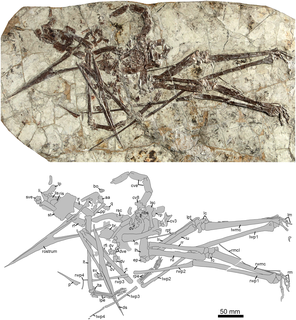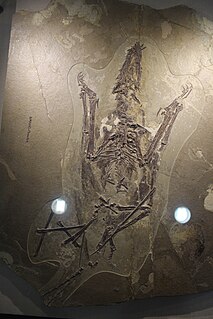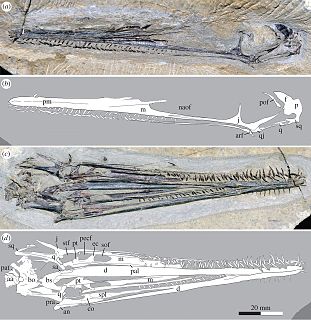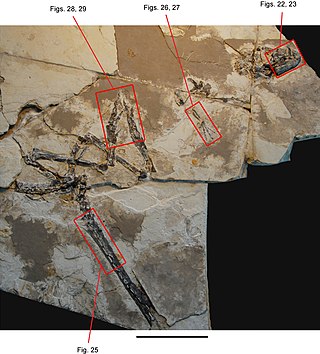 W
WAnchiornis is a genus of small, four-winged paravian dinosaur. The genus Anchiornis contains only the type species Anchiornis huxleyi, named for its similarity to modern birds. Anchiornis fossils have been only found in the Tiaojishan Formation of Liaoning, China, in rocks dated to the Late Jurassic, about 160 million years ago. Anchiornis is known from hundreds of specimens, and given the exquisite preservation of some of these fossils, it became the first Mesozoic dinosaur species for which almost the entire life appearance could be determined, and an important source of information on the early evolution of birds. Anchiornis huxleyi translates to "Huxley's near-bird" in Greek.
 W
WAurornis is an extinct genus of anchiornithid theropod dinosaurs from the Jurassic period of China. The genus Aurornis contains a single known species, Aurornis xui. Aurornis xui may be the most basal ("primitive") avialan dinosaur known to date, and it is one of the earliest avialans found to date. The fossil evidence for the animal pre-dates that of Archaeopteryx lithographica, often considered the earliest bird species, by about 10 million years.
 W
WChangyuraptor is a genus of "four-winged", predatory dinosaurs. It is known from a single fossil specimen representing the species Changyuraptor yangi, which was discovered from Early Cretaceous deposits in Liaoning Province, China. C. yangi belongs to the group of dromaeosaurid theropod dinosaurs called the Microraptoria.
 W
WThe Chaoyangopteridae are a family of pterosaurs within the Azhdarchoidea.
 W
WChaoyangsaurus was a marginocephalian dinosaur from the Late Jurassic of China. Chaoyangsaurus belonged to the Ceratopsia, Chaoyangsaurus, like all ceratopsians, was primarily a herbivore.
 W
WEosinopteryx is an extinct genus of theropod dinosaurs known the late Jurassic period of China. It contains a single species, Eosinopteryx brevipenna.
 W
WFenghuangopterus is a genus of basal pterosaur that lived in northeastern China during the Middle Jurassic.
 W
WIkrandraco is a genus of lonchodectid pterodactyloid pterosaur known from Lower Cretaceous rocks in northeastern China, and the Cambridge Greensand of the UK. It is notable for its unusual skull, which features a crest on the lower jaw.
 W
WThe Jehol Biota includes all the living organisms – the ecosystem – of northeastern China between 133 and 120 million years ago. This is the Lower Cretaceous ecosystem which left fossils in the Yixian Formation and Jiufotang Formation. These deposits are composed of layers of tephra and sediment. It is also believed to have left fossils in the Sinuiju series of North Korea. The ecosystem in the Lower Cretaceous was dominated by wetlands and numerous lakes. Rainfall was seasonal, alternating between semiarid and mesic conditions. The climate was temperate. The Jehol ecosystem was interrupted periodically by ash eruptions from volcanoes to the west. The word "Jehol" is a historical transcription of the former Rehe Province.
 W
WThe Jiufotang Formation is an Early Cretaceous geological formation in Chaoyang, Liaoning which has yielded fossils of feathered dinosaurs, primitive birds, pterosaurs, and other organisms. It is a member of the Jehol group. The exact age of the Jiufotang has been debated for years, with estimates ranging from the Late Jurassic to the Early Cretaceous. He et al. (2004) used argon - isotope radiometry to confirm biostratigraphic age estimates. They confirmed an Early Cretaceous, Aptian age for the Jiufotang Formation, 120.3 +/-0.7 million years ago. Fossils of Microraptor and Jeholornis are from the Jiufotang.
 W
WLiaodactylus is a genus of filter-feeding ctenochasmatid pterosaur from the Jurassic of China. The genus contains one species, L. primus, described by Zhou et al. in 2017. As an adaptation to filter-feeding, Liaodactylus had approximately 150 long, comb-like teeth packed closely together. It is both the earliest known ctenochasmatid and the first filter-feeding pterosaur from the Jurassic Tiaojishan Formation. Later and more specialized ctenochasmatids differ from Liaodactylus in having longer snouts, smaller openings in the skull, and more teeth. Within the Ctenochasmatidae, Liaodactylus was most closely related to the European Ctenochasma.
 W
WLongusunguis is an extinct genus of bohaiornithid enantiornithean dinosaur known from the Early Cretaceous of Liaoning Province, northeastern China. It contains a single species, Longusunguis kurochkini.
 W
WMei is a genus of duck-sized troodontid dinosaur first unearthed by paleontologists from the Yixian Formation in Liaoning, China in 2004. Mei lived during the Early Cretaceous period. The binomial name of its only species, Mei long, means sleeping dragon.
 W
WNurhachius is a genus of istiodactylid pterodactyloid pterosaur from the Barremian to Aptian-age Lower Cretaceous Jiufotang Formation of Chaoyang, Liaoning, China. Its fossil remains dated back about 120 million years ago.
 W
WPiscivoravis is an extinct genus of fish-eating ornithuromorphs known from the Early Cretaceous Jiufotang Formation of western Liaoning Province, northeastern China. Piscivoravis was first named by Shuang Zhou, Zhonghe Zhou and Jingmai O'Connor in 2013 and the type species is Piscivoravis lii. Phylogenetic analysis places Piscivoravis in a more derived position than Archaeorhynchus, in a polytomy with Jianchangornis, Patagopteryx, and the clade including all more derived ornithuromorphs.
 W
WSerikornis is a genus of small, feathered anchiornithid dinosaur from the Upper Jurassic Tiaojishan Formation of Liaoning, China. It is represented by the type species Serikornis sungei.
 W
WSulcavis is a genus of enantiornithean birds. One species is named, Sulcavis geeorum. The fossil was found in Early Cretaceous rocks in Liaoning Province, China.
 W
WThe Sunjiawan Formation is a geological formation in Liaoning, China, with strata possibly dating back to the early Late Cretaceous, specifically the Cenomanian. Dinosaur remains are among the fossils that have been recovered from the formation. It forms part of the same geological sequence as the older and underlying Yixian Formation and Jiufotang Formation. It primarily consists of variegated conglomerates with rare intercalations of thin bedded sandstones, siltstones and mudstones.
 W
WTianyulong was a genus of heterodontosaurid ornithischian dinosaur. The only species was T. confuciusi, whose remains were discovered in Jianchang County, Western Liaoning Province, China.
 W
WThe Tiaojishan Formation is a geological formation in Hebei and Liaoning, People's Republic of China, dating to the middle-late Jurassic period. It is known for its exceptionally preserved fossils, including those of plants, insects and vertebrates. It is made up mainly of pyroclastic rock interspersed with basic volcanic and sedimentary rocks. Previously, the Tiaojishan Formation was grouped together with the underlying Haifanggou Formation as a single "Lanqi Formation." Most researchers now agree that the Daohugou Bed, of formerly controversial dating, is a part of the Tiaojishan formation. The Tiaojishan Formation forms a key part of the Yanliao Biota assemblage.
 W
WThe Tuchengzi Formation is a geological formation in China whose strata span the Tithonian to Berriasian ages. Dinosaur fossils, particularly footprints, have been found from the formation.
 W
WXiaotingia is a genus of anchiornithid theropod dinosaur from early Late Jurassic deposits of western Liaoning, China, containing a single species, Xiaotingia zhengi.
 W
WThe Yanliao Biota is the name given to an assembly of fossils preserved in northeastern China from the Middle Jurassic to Early Cretaceous. It includes fossils from the Tiaojishan Formation, Lanqi Formation, Jiulongshan Formation and Haifanggou Formation. This spans approximately 199 to 146 million years ago.
 W
WThe Yixian Formation is a geological formation in Jinzhou, Liaoning, People's Republic of China, that spans 11 million years during the early Cretaceous period. It is known for its exquisitely preserved fossils, and is mainly composed of basalts interspersed with siliciclastic sediments.
 W
WZhouornis is an extinct genus of enantiornithine bird known from the Early Cretaceous Jehol Group of western Liaoning Province, northeastern China. Zhouornis was first named by Zihui Zhang, Luis M. Chiappe, Gang Han and Anusuya Chinsamy in 2013 and the type species is Zhouornis hani.